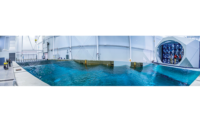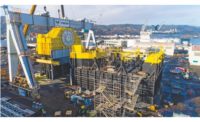University of Maine Wind-Wave Test Tank To Model Ocean Storm Impacts


"The facility will house a wind tunnel that rotates above the wave basin, allowing it to create wind storms from different directions," says Habib Dagher, director of the Advanced Structures and Composites Center at the flagship state university campus in Orono. "When the open-jet wind tunnel rotates, it can change the direction of the wind and replicate a wind-shear profile by changing the wind speed with height."
Scheduled to open in April, the basin is part of an $8-million expansion of the facility, known as W², to 100,000 sq ft from 90,000 sq ft.
According to Cianbro Project Manager Bruce Cummings, placement of the 3-ft-ballast-slab floor is complete, and crews are shotcreting the walls. He says the biggest challenge is forming the wave basin—which is to be 110 ft long, 33 ft wide and 18 ft deep— using shotcrete.
"We're mixing concrete on-site and spraying it against a one-sided form," he says. "We haven't built a pool or tank using shotcrete before."
A positioning system within the open-jet system, which uses 40 2-ft-dia fans capable of simulating winds of up to 220 mph, swings on vertical and horizontal axes and recirculates the wind. Each fan can be controlled individually.
For tests, a 1/50th-scale subject sits in an open section of the basin; a recirculating feature enables shifting wind direction relative to the waves, much like squall conditions at sea during storms. In model equivalents, 2-ft waves and 10-mph winds represent 100-ft waves and 100-mph winds at full scale.
Dagher says that, in addition to being able to test a variety of offshore wind, wave and tidal energy-harvesting systems as well as oil-and-gas platforms and ship structures, a "beach" at one end of the basin also enables analysis of storms and climate-change impacts on beach erosion.
"It will allow us to build a model of a city and apply seven potentially new environments to evaluate the effects of sea-level rise," Dagher says.
The Maine Maritime Academy in Castine, Maine, which developed the design in partnership with other groups on the project, is working through the computational fluid dynamics data.
The team ran the CFD studies using OpenFoam software and other proprietary software, developed by the university. The wind-wave basin requires five distinct systems. The project has issued requests for proposals for the open-jet wind tunnel, the wave basin, the wave-making equipment, the moving floor and the beach area that attenuates waves.
In coming months, a commissioning team will evaluate each piece of equipment before designing a proprietary supervisory control and data-acquisition network to control all systems.
Before investing in the venture, the university conducted an anonymous survey of executives at 50 firms in ocean energy, oil-and-gas, and boat- and shipbuilding sectors to gauge interest in the facility.
"The responses about how they could potentially use [it] were extremely positive," Dagher says.
Although wave-basin components exist around the world, none are as integrated as at the Orono facility, says Krish Thiagarajan, a mechanical engineering professor and the project's principal investigator.
"The challenge of modeling the ocean with all its complexities and housing in that small of a building is like playing God," he says.






